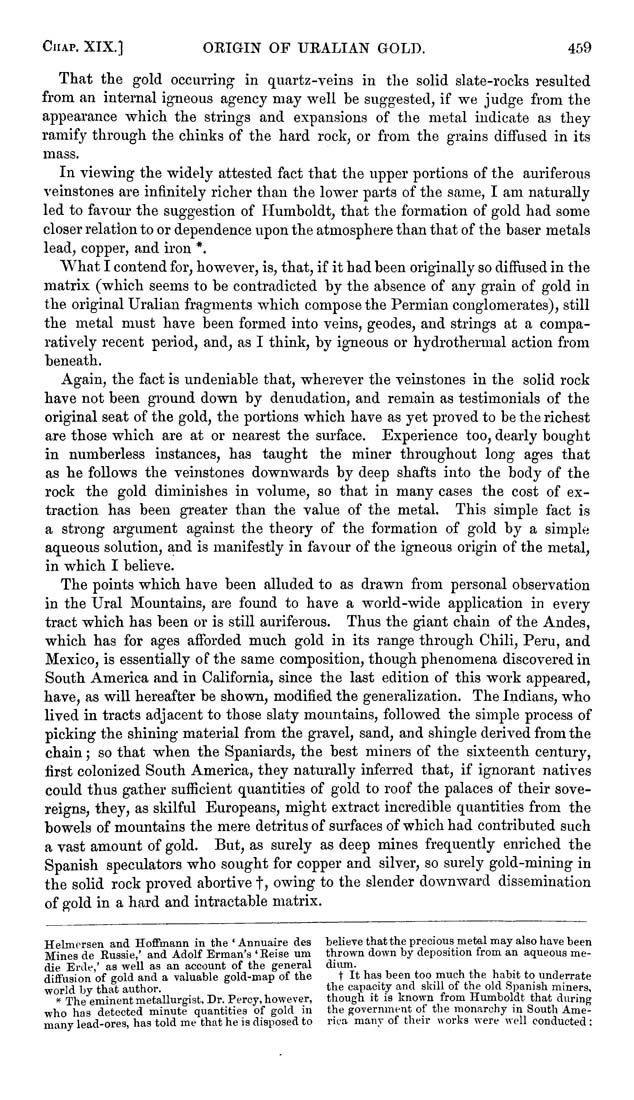Chap. XIX.] ORIGIN OF URALIAN GOLD. 459
That the gold occurring in quartz-veins in the solid slate-rocks resulted
from an internal igneous agency may well be suggested, if we judge from the
appearance which the strings and expansions of the metal indicate as they
ramify through the chinks of the hard rock, or from the grains difi'used in its
mass.
In viewing the widely attested fact that the upper portions of the auriferous
veinstones are infinitely richer than the lower parts of the same, I am naturaUy
led to favour the suggestion of Humboldt, that the formation of gold had some
closer relation to or dependence upon the atmosphere than that of the baser metals
lead, copper, and iron *.
What I contend for, however, is, that, if it had been originally so diffiised in the
matrix (which seems to be contradicted by the absence of any grain of gold in
the original Uralian fragments which compose the Permian conglomerates), still
the metal must have been formed into veins, geodes, and strings at a compa¬
ratively recent period, and, as I think, by igneous or hydrothermal action from
beneath.
Again, the fact is undeniable that, wherever the veinstones in the solid rock
have not been ground down by denudation, and remain as testimonials of the
original seat of the gold, the portions which have as yet proved to be the richest
are those which are at or nearest the surface. Experience too, dearly bought
in numberless instances, has taught the miner throughout long ages that
as he foUows the veinstones downwards by deep shafts into the body of the
rock the gold diminishes in volume, so that in many cases the cost of ex¬
traction has been greater than the value of the metal. This simple fact is
a strong argument against the theory of the formation of gold by a simple
aqueous solution, and is manifestly in favour of the igneous origin of the metal,
in which I believe.
The points which have been alluded to as drav^n from personal observation
in the Ural Mountains, are found to have a world-wide application in every
tract which has been or is still auriferous. Thus the giant chain of the Andes,
which has for ages aflforded much gold in its range through Chili, Peru, and
Mexico, is essentially ofthe same composition, though phenomena discovered in
South America and in California, since the last edition of this work appeared,
have, as wiU hereafter be shown, modified the generalization. The Indians, who
lived in tracts adjacent to those slaty mountains, followed the simple process of
picking the shining material from the gravel, sand, and shingle derived from the
chain; so that when the Spaniards, the best miners of the sixteenth century,
first colonized South America, they naturally inferred that, if ignorant natives
could thus gather sufficient quantities of gold to roof the palaces of their sove¬
reigns, they, as skilful Europeans, might extract incredible quantities from the
bowels of mountains the mere detritus of surfaces of which had contributed such
a vast amount of gold. But, as surely as deep mines frequently enriched the
Spanish speculators who sought for copper and silver, so surely gold-mining in
the solid rock proved abortive tj owing to the slender downward dissemination
of gold in a hard and intractable matrix.
Helmersen and Hoffmann in the 'Annuaire des believe that the precious metal may also have been
Mines de Eussie,' and Adolf Erman's 'Eeise um thrown down by deposition from an aqueous me¬
dic Erde,' as well as an account of the general diimi.
diffusion of gold and a valuable gold-map of the t It has been too much the habit to underrate
world by that author. the capacity and skill of the old Spanish miners,
* The eminent metallurgist, Dr. Percy, however, though it is known from Humboldt that during
who has detected minute quantities of gold in the government of the monarchy in South Ame-
many lead-ores, has told me that he is disposed to rica many of their works were well conducted :
|








